Data Analysis and Mining Assignment
VerifiedAdded on 2020/07/22
|28
|2628
|100
AI Summary
The provided assignment is focused on data analysis and mining techniques. It starts with identifying outliers in the data set, which reduces the size from 4899 to 4074 after applying a rule-based approach. The task then proceeds with dividing the data into training and test sets of equal sizes using a forward selection method to build a working model. Additionally, it involves creating a Tableau Desktop View of snowfall data at Whistler, BC, Canada, over time.
Contribute Materials
Your contribution can guide someone’s learning journey. Share your
documents today.
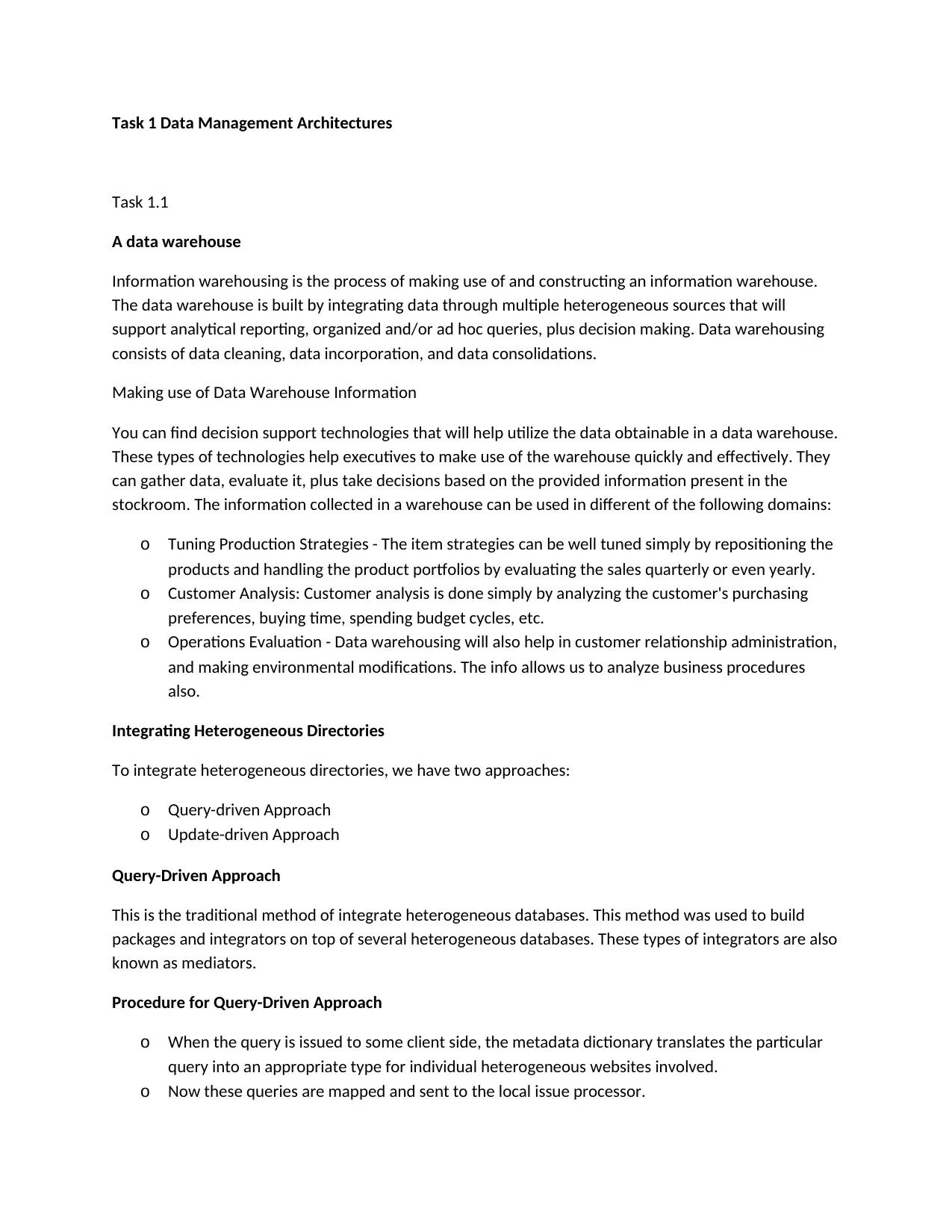
Task 1 Data Management Architectures
Task 1.1
A data warehouse
Information warehousing is the process of making use of and constructing an information warehouse.
The data warehouse is built by integrating data through multiple heterogeneous sources that will
support analytical reporting, organized and/or ad hoc queries, plus decision making. Data warehousing
consists of data cleaning, data incorporation, and data consolidations.
Making use of Data Warehouse Information
You can find decision support technologies that will help utilize the data obtainable in a data warehouse.
These types of technologies help executives to make use of the warehouse quickly and effectively. They
can gather data, evaluate it, plus take decisions based on the provided information present in the
stockroom. The information collected in a warehouse can be used in different of the following domains:
o Tuning Production Strategies - The item strategies can be well tuned simply by repositioning the
products and handling the product portfolios by evaluating the sales quarterly or even yearly.
o Customer Analysis: Customer analysis is done simply by analyzing the customer's purchasing
preferences, buying time, spending budget cycles, etc.
o Operations Evaluation - Data warehousing will also help in customer relationship administration,
and making environmental modifications. The info allows us to analyze business procedures
also.
Integrating Heterogeneous Directories
To integrate heterogeneous directories, we have two approaches:
o Query-driven Approach
o Update-driven Approach
Query-Driven Approach
This is the traditional method of integrate heterogeneous databases. This method was used to build
packages and integrators on top of several heterogeneous databases. These types of integrators are also
known as mediators.
Procedure for Query-Driven Approach
o When the query is issued to some client side, the metadata dictionary translates the particular
query into an appropriate type for individual heterogeneous websites involved.
o Now these queries are mapped and sent to the local issue processor.
Task 1.1
A data warehouse
Information warehousing is the process of making use of and constructing an information warehouse.
The data warehouse is built by integrating data through multiple heterogeneous sources that will
support analytical reporting, organized and/or ad hoc queries, plus decision making. Data warehousing
consists of data cleaning, data incorporation, and data consolidations.
Making use of Data Warehouse Information
You can find decision support technologies that will help utilize the data obtainable in a data warehouse.
These types of technologies help executives to make use of the warehouse quickly and effectively. They
can gather data, evaluate it, plus take decisions based on the provided information present in the
stockroom. The information collected in a warehouse can be used in different of the following domains:
o Tuning Production Strategies - The item strategies can be well tuned simply by repositioning the
products and handling the product portfolios by evaluating the sales quarterly or even yearly.
o Customer Analysis: Customer analysis is done simply by analyzing the customer's purchasing
preferences, buying time, spending budget cycles, etc.
o Operations Evaluation - Data warehousing will also help in customer relationship administration,
and making environmental modifications. The info allows us to analyze business procedures
also.
Integrating Heterogeneous Directories
To integrate heterogeneous directories, we have two approaches:
o Query-driven Approach
o Update-driven Approach
Query-Driven Approach
This is the traditional method of integrate heterogeneous databases. This method was used to build
packages and integrators on top of several heterogeneous databases. These types of integrators are also
known as mediators.
Procedure for Query-Driven Approach
o When the query is issued to some client side, the metadata dictionary translates the particular
query into an appropriate type for individual heterogeneous websites involved.
o Now these queries are mapped and sent to the local issue processor.
Secure Best Marks with AI Grader
Need help grading? Try our AI Grader for instant feedback on your assignments.
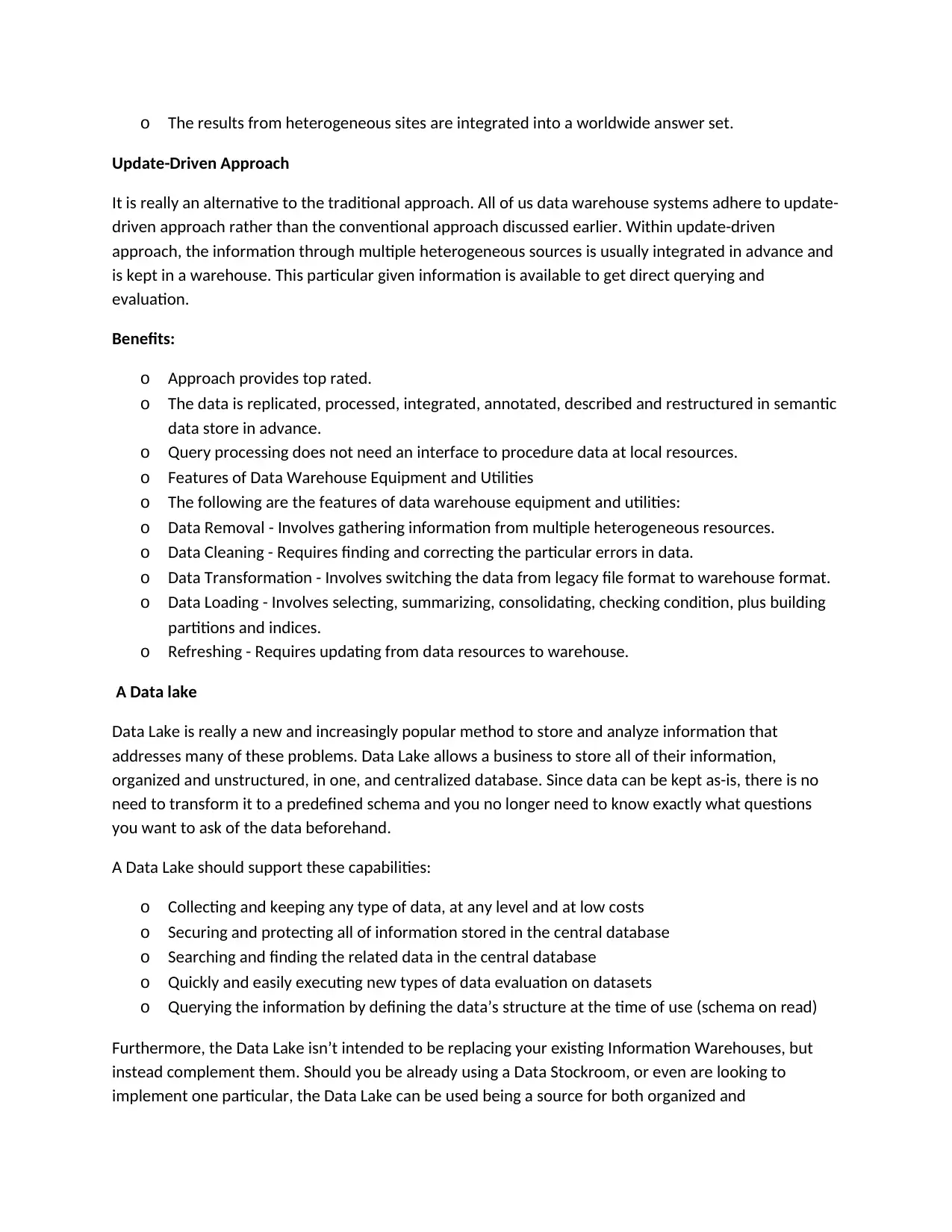
o The results from heterogeneous sites are integrated into a worldwide answer set.
Update-Driven Approach
It is really an alternative to the traditional approach. All of us data warehouse systems adhere to update-
driven approach rather than the conventional approach discussed earlier. Within update-driven
approach, the information through multiple heterogeneous sources is usually integrated in advance and
is kept in a warehouse. This particular given information is available to get direct querying and
evaluation.
Benefits:
o Approach provides top rated.
o The data is replicated, processed, integrated, annotated, described and restructured in semantic
data store in advance.
o Query processing does not need an interface to procedure data at local resources.
o Features of Data Warehouse Equipment and Utilities
o The following are the features of data warehouse equipment and utilities:
o Data Removal - Involves gathering information from multiple heterogeneous resources.
o Data Cleaning - Requires finding and correcting the particular errors in data.
o Data Transformation - Involves switching the data from legacy file format to warehouse format.
o Data Loading - Involves selecting, summarizing, consolidating, checking condition, plus building
partitions and indices.
o Refreshing - Requires updating from data resources to warehouse.
A Data lake
Data Lake is really a new and increasingly popular method to store and analyze information that
addresses many of these problems. Data Lake allows a business to store all of their information,
organized and unstructured, in one, and centralized database. Since data can be kept as-is, there is no
need to transform it to a predefined schema and you no longer need to know exactly what questions
you want to ask of the data beforehand.
A Data Lake should support these capabilities:
o Collecting and keeping any type of data, at any level and at low costs
o Securing and protecting all of information stored in the central database
o Searching and finding the related data in the central database
o Quickly and easily executing new types of data evaluation on datasets
o Querying the information by defining the data’s structure at the time of use (schema on read)
Furthermore, the Data Lake isn’t intended to be replacing your existing Information Warehouses, but
instead complement them. Should you be already using a Data Stockroom, or even are looking to
implement one particular, the Data Lake can be used being a source for both organized and
Update-Driven Approach
It is really an alternative to the traditional approach. All of us data warehouse systems adhere to update-
driven approach rather than the conventional approach discussed earlier. Within update-driven
approach, the information through multiple heterogeneous sources is usually integrated in advance and
is kept in a warehouse. This particular given information is available to get direct querying and
evaluation.
Benefits:
o Approach provides top rated.
o The data is replicated, processed, integrated, annotated, described and restructured in semantic
data store in advance.
o Query processing does not need an interface to procedure data at local resources.
o Features of Data Warehouse Equipment and Utilities
o The following are the features of data warehouse equipment and utilities:
o Data Removal - Involves gathering information from multiple heterogeneous resources.
o Data Cleaning - Requires finding and correcting the particular errors in data.
o Data Transformation - Involves switching the data from legacy file format to warehouse format.
o Data Loading - Involves selecting, summarizing, consolidating, checking condition, plus building
partitions and indices.
o Refreshing - Requires updating from data resources to warehouse.
A Data lake
Data Lake is really a new and increasingly popular method to store and analyze information that
addresses many of these problems. Data Lake allows a business to store all of their information,
organized and unstructured, in one, and centralized database. Since data can be kept as-is, there is no
need to transform it to a predefined schema and you no longer need to know exactly what questions
you want to ask of the data beforehand.
A Data Lake should support these capabilities:
o Collecting and keeping any type of data, at any level and at low costs
o Securing and protecting all of information stored in the central database
o Searching and finding the related data in the central database
o Quickly and easily executing new types of data evaluation on datasets
o Querying the information by defining the data’s structure at the time of use (schema on read)
Furthermore, the Data Lake isn’t intended to be replacing your existing Information Warehouses, but
instead complement them. Should you be already using a Data Stockroom, or even are looking to
implement one particular, the Data Lake can be used being a source for both organized and
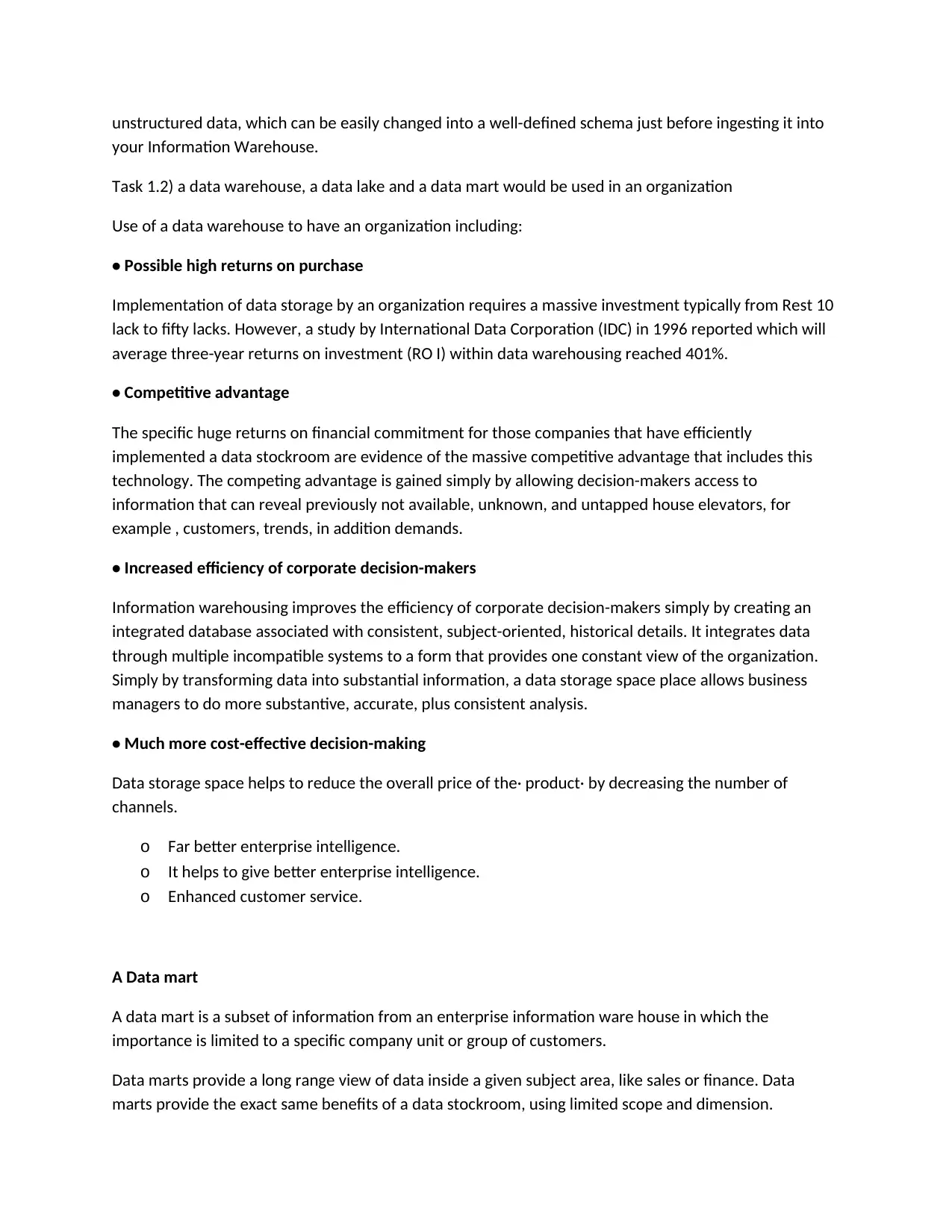
unstructured data, which can be easily changed into a well-defined schema just before ingesting it into
your Information Warehouse.
Task 1.2) a data warehouse, a data lake and a data mart would be used in an organization
Use of a data warehouse to have an organization including:
• Possible high returns on purchase
Implementation of data storage by an organization requires a massive investment typically from Rest 10
lack to fifty lacks. However, a study by International Data Corporation (IDC) in 1996 reported which will
average three-year returns on investment (RO I) within data warehousing reached 401%.
• Competitive advantage
The specific huge returns on financial commitment for those companies that have efficiently
implemented a data stockroom are evidence of the massive competitive advantage that includes this
technology. The competing advantage is gained simply by allowing decision-makers access to
information that can reveal previously not available, unknown, and untapped house elevators, for
example , customers, trends, in addition demands.
• Increased efficiency of corporate decision-makers
Information warehousing improves the efficiency of corporate decision-makers simply by creating an
integrated database associated with consistent, subject-oriented, historical details. It integrates data
through multiple incompatible systems to a form that provides one constant view of the organization.
Simply by transforming data into substantial information, a data storage space place allows business
managers to do more substantive, accurate, plus consistent analysis.
• Much more cost-effective decision-making
Data storage space helps to reduce the overall price of the· product· by decreasing the number of
channels.
o Far better enterprise intelligence.
o It helps to give better enterprise intelligence.
o Enhanced customer service.
A Data mart
A data mart is a subset of information from an enterprise information ware house in which the
importance is limited to a specific company unit or group of customers.
Data marts provide a long range view of data inside a given subject area, like sales or finance. Data
marts provide the exact same benefits of a data stockroom, using limited scope and dimension.
your Information Warehouse.
Task 1.2) a data warehouse, a data lake and a data mart would be used in an organization
Use of a data warehouse to have an organization including:
• Possible high returns on purchase
Implementation of data storage by an organization requires a massive investment typically from Rest 10
lack to fifty lacks. However, a study by International Data Corporation (IDC) in 1996 reported which will
average three-year returns on investment (RO I) within data warehousing reached 401%.
• Competitive advantage
The specific huge returns on financial commitment for those companies that have efficiently
implemented a data stockroom are evidence of the massive competitive advantage that includes this
technology. The competing advantage is gained simply by allowing decision-makers access to
information that can reveal previously not available, unknown, and untapped house elevators, for
example , customers, trends, in addition demands.
• Increased efficiency of corporate decision-makers
Information warehousing improves the efficiency of corporate decision-makers simply by creating an
integrated database associated with consistent, subject-oriented, historical details. It integrates data
through multiple incompatible systems to a form that provides one constant view of the organization.
Simply by transforming data into substantial information, a data storage space place allows business
managers to do more substantive, accurate, plus consistent analysis.
• Much more cost-effective decision-making
Data storage space helps to reduce the overall price of the· product· by decreasing the number of
channels.
o Far better enterprise intelligence.
o It helps to give better enterprise intelligence.
o Enhanced customer service.
A Data mart
A data mart is a subset of information from an enterprise information ware house in which the
importance is limited to a specific company unit or group of customers.
Data marts provide a long range view of data inside a given subject area, like sales or finance. Data
marts provide the exact same benefits of a data stockroom, using limited scope and dimension.
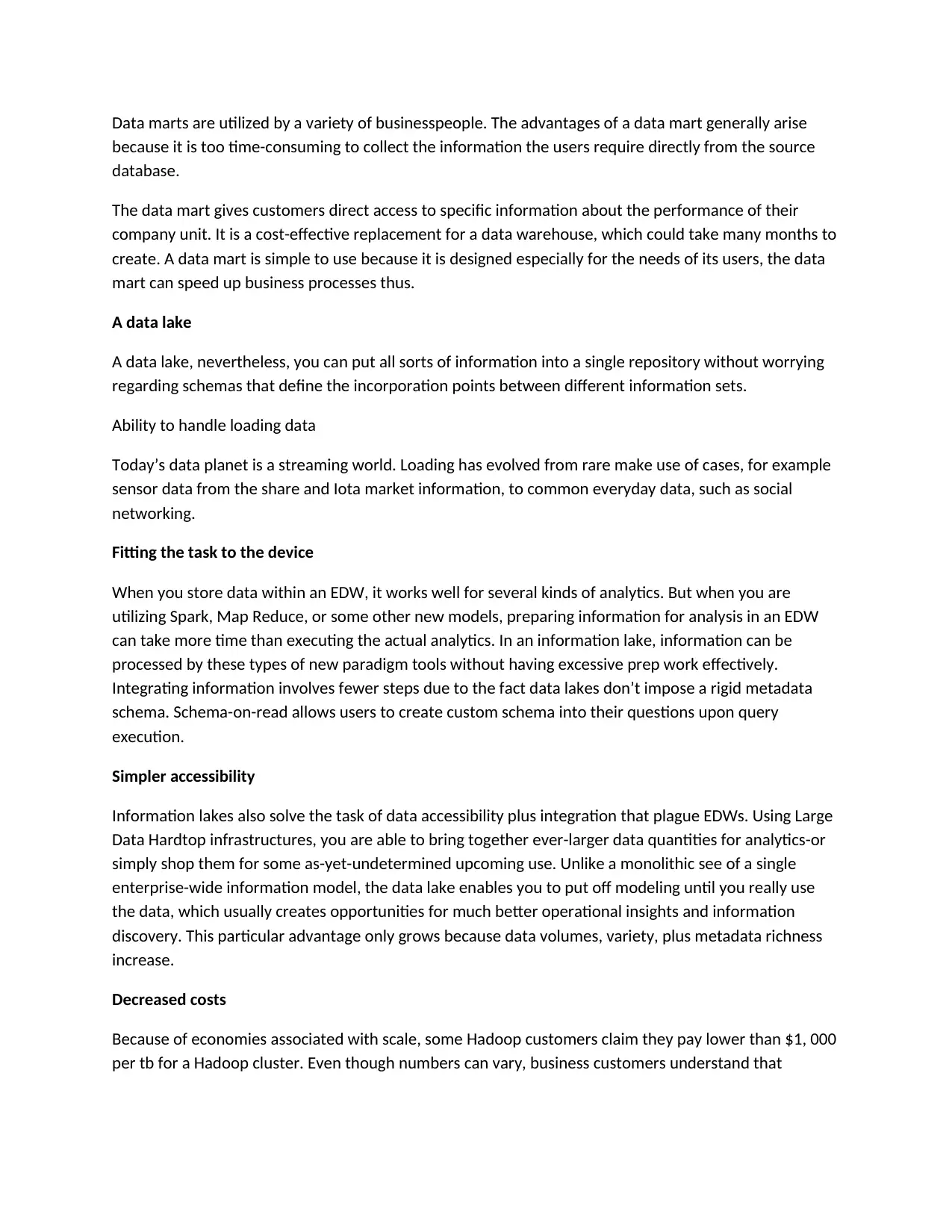
Data marts are utilized by a variety of businesspeople. The advantages of a data mart generally arise
because it is too time-consuming to collect the information the users require directly from the source
database.
The data mart gives customers direct access to specific information about the performance of their
company unit. It is a cost-effective replacement for a data warehouse, which could take many months to
create. A data mart is simple to use because it is designed especially for the needs of its users, the data
mart can speed up business processes thus.
A data lake
A data lake, nevertheless, you can put all sorts of information into a single repository without worrying
regarding schemas that define the incorporation points between different information sets.
Ability to handle loading data
Today’s data planet is a streaming world. Loading has evolved from rare make use of cases, for example
sensor data from the share and Iota market information, to common everyday data, such as social
networking.
Fitting the task to the device
When you store data within an EDW, it works well for several kinds of analytics. But when you are
utilizing Spark, Map Reduce, or some other new models, preparing information for analysis in an EDW
can take more time than executing the actual analytics. In an information lake, information can be
processed by these types of new paradigm tools without having excessive prep work effectively.
Integrating information involves fewer steps due to the fact data lakes don’t impose a rigid metadata
schema. Schema-on-read allows users to create custom schema into their questions upon query
execution.
Simpler accessibility
Information lakes also solve the task of data accessibility plus integration that plague EDWs. Using Large
Data Hardtop infrastructures, you are able to bring together ever-larger data quantities for analytics-or
simply shop them for some as-yet-undetermined upcoming use. Unlike a monolithic see of a single
enterprise-wide information model, the data lake enables you to put off modeling until you really use
the data, which usually creates opportunities for much better operational insights and information
discovery. This particular advantage only grows because data volumes, variety, plus metadata richness
increase.
Decreased costs
Because of economies associated with scale, some Hadoop customers claim they pay lower than $1, 000
per tb for a Hadoop cluster. Even though numbers can vary, business customers understand that
because it is too time-consuming to collect the information the users require directly from the source
database.
The data mart gives customers direct access to specific information about the performance of their
company unit. It is a cost-effective replacement for a data warehouse, which could take many months to
create. A data mart is simple to use because it is designed especially for the needs of its users, the data
mart can speed up business processes thus.
A data lake
A data lake, nevertheless, you can put all sorts of information into a single repository without worrying
regarding schemas that define the incorporation points between different information sets.
Ability to handle loading data
Today’s data planet is a streaming world. Loading has evolved from rare make use of cases, for example
sensor data from the share and Iota market information, to common everyday data, such as social
networking.
Fitting the task to the device
When you store data within an EDW, it works well for several kinds of analytics. But when you are
utilizing Spark, Map Reduce, or some other new models, preparing information for analysis in an EDW
can take more time than executing the actual analytics. In an information lake, information can be
processed by these types of new paradigm tools without having excessive prep work effectively.
Integrating information involves fewer steps due to the fact data lakes don’t impose a rigid metadata
schema. Schema-on-read allows users to create custom schema into their questions upon query
execution.
Simpler accessibility
Information lakes also solve the task of data accessibility plus integration that plague EDWs. Using Large
Data Hardtop infrastructures, you are able to bring together ever-larger data quantities for analytics-or
simply shop them for some as-yet-undetermined upcoming use. Unlike a monolithic see of a single
enterprise-wide information model, the data lake enables you to put off modeling until you really use
the data, which usually creates opportunities for much better operational insights and information
discovery. This particular advantage only grows because data volumes, variety, plus metadata richness
increase.
Decreased costs
Because of economies associated with scale, some Hadoop customers claim they pay lower than $1, 000
per tb for a Hadoop cluster. Even though numbers can vary, business customers understand that
Secure Best Marks with AI Grader
Need help grading? Try our AI Grader for instant feedback on your assignments.

because it’s no more excessively costly for them to shop all their data, they could maintain copies of
everything simply by dumping it into Hadoop simply, to become discovered and analyzed later on.
Scalability
Huge Data is typically defined as the particular intersection between volume, variety, plus velocity.
EDWs are well known for not being able to scale over and above a certain volume due to limitations of
the architecture. Data digesting takes so long that institutions are prevented from taking advantage of
all their data to the fullest extent. Using Hadoop, petabyte- scale data lakes are cost-efficient and simple
to create and maintain at whatever size is desired relatively.
A data mart:
o To partition data to be able to impose access control techniques.
o To speed up the questions by reducing the volume associated with data to be scanned.
o To segment data into various hardware platforms.
o To framework data in a form ideal for a user access tool.
Budget-friendly Data Marting
Follow the actions given below to make information marting cost-effective:
o Identify the particular Functional Splits
o Identify Consumer Access Tool Requirements
o Identify Access Control Issues
A retail organization, exactly where each merchant is responsible for maximizing the sales of the group
of products. With this, the following are the valuable info:
o sales transaction on a daily basis
o sales forecast on a weekly schedule
o stock position on a daily basis
o stock movements on a daily basis
As the service provider is not interested in the products they may not be dealing with, the data marting
is really a subset of the data coping which the product group of curiosity. The following diagram shows
information marting for different users.
everything simply by dumping it into Hadoop simply, to become discovered and analyzed later on.
Scalability
Huge Data is typically defined as the particular intersection between volume, variety, plus velocity.
EDWs are well known for not being able to scale over and above a certain volume due to limitations of
the architecture. Data digesting takes so long that institutions are prevented from taking advantage of
all their data to the fullest extent. Using Hadoop, petabyte- scale data lakes are cost-efficient and simple
to create and maintain at whatever size is desired relatively.
A data mart:
o To partition data to be able to impose access control techniques.
o To speed up the questions by reducing the volume associated with data to be scanned.
o To segment data into various hardware platforms.
o To framework data in a form ideal for a user access tool.
Budget-friendly Data Marting
Follow the actions given below to make information marting cost-effective:
o Identify the particular Functional Splits
o Identify Consumer Access Tool Requirements
o Identify Access Control Issues
A retail organization, exactly where each merchant is responsible for maximizing the sales of the group
of products. With this, the following are the valuable info:
o sales transaction on a daily basis
o sales forecast on a weekly schedule
o stock position on a daily basis
o stock movements on a daily basis
As the service provider is not interested in the products they may not be dealing with, the data marting
is really a subset of the data coping which the product group of curiosity. The following diagram shows
information marting for different users.

Task 2 Exploratory Data Analysis and Linear Regression Analysis
Task 2.1
All variables are summarized and unit variety analysis with plots is shown below.
Task 2.1
All variables are summarized and unit variety analysis with plots is shown below.

Paraphrase This Document
Need a fresh take? Get an instant paraphrase of this document with our AI Paraphraser
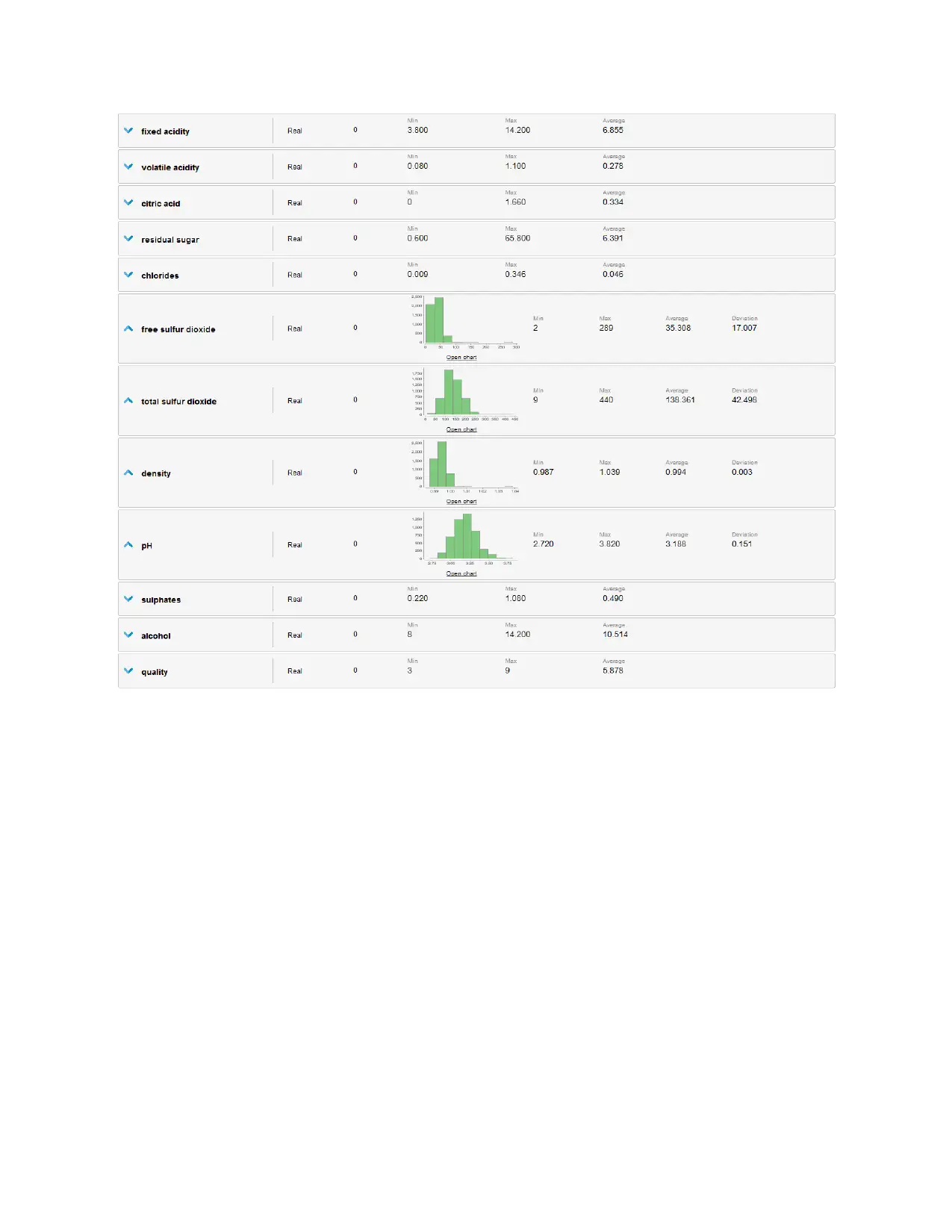

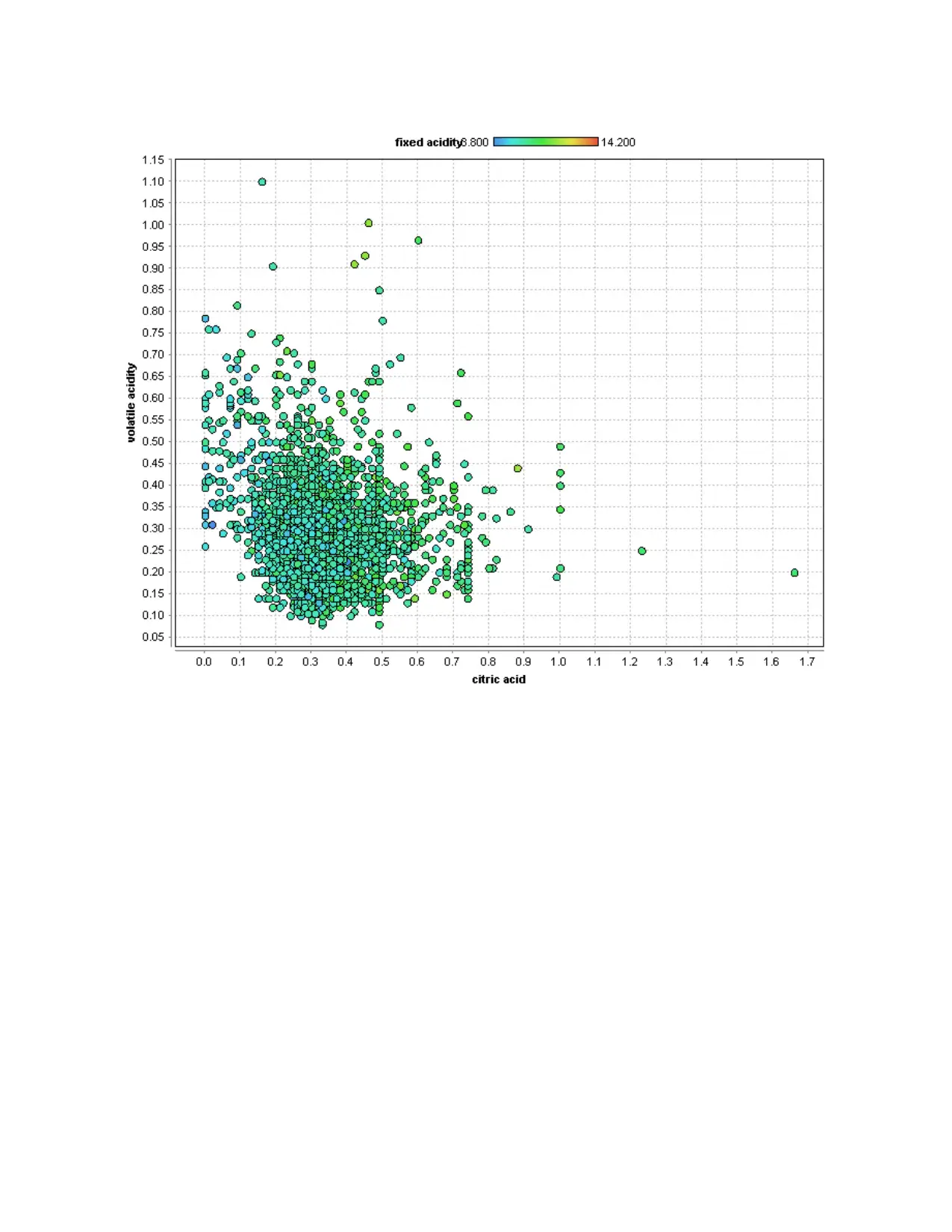
Secure Best Marks with AI Grader
Need help grading? Try our AI Grader for instant feedback on your assignments.
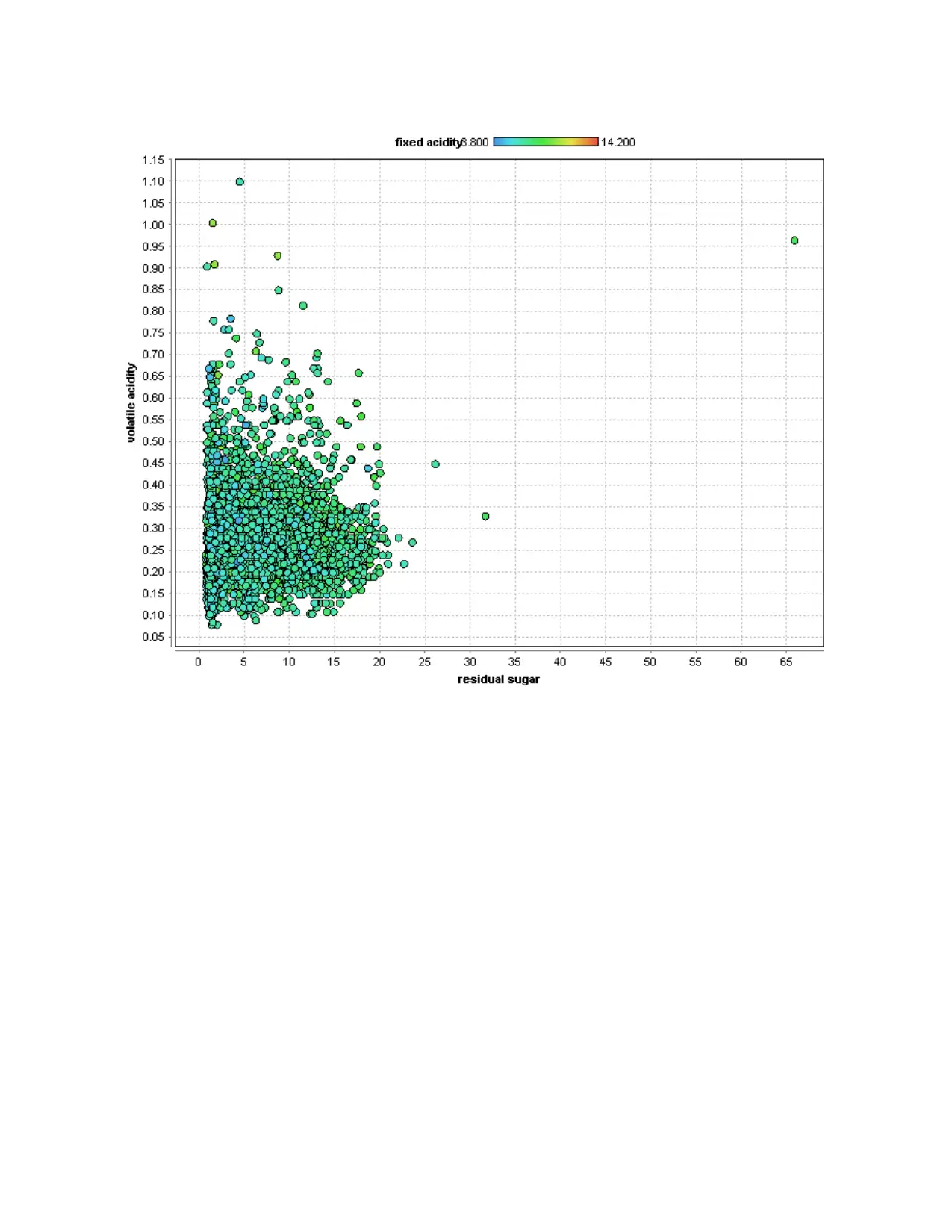
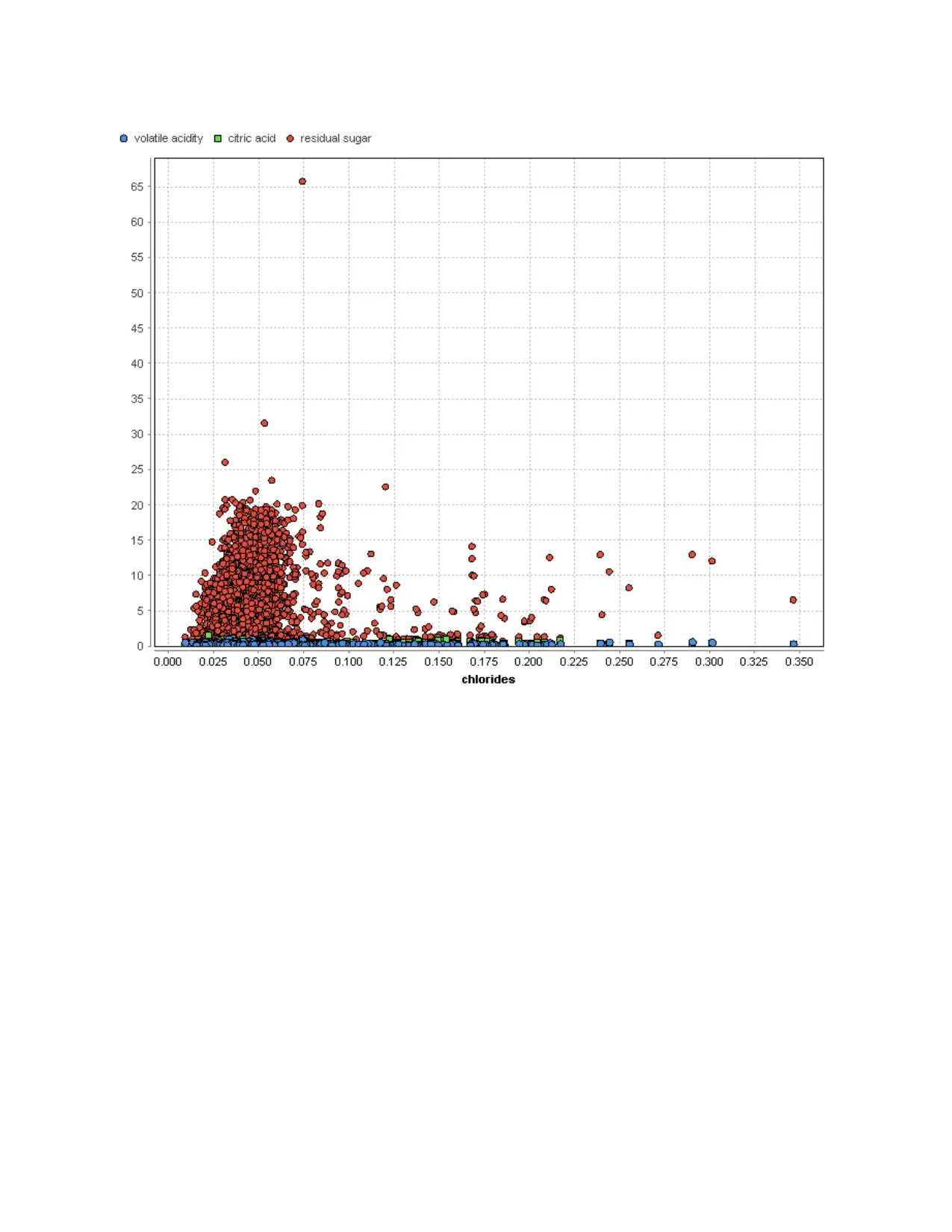
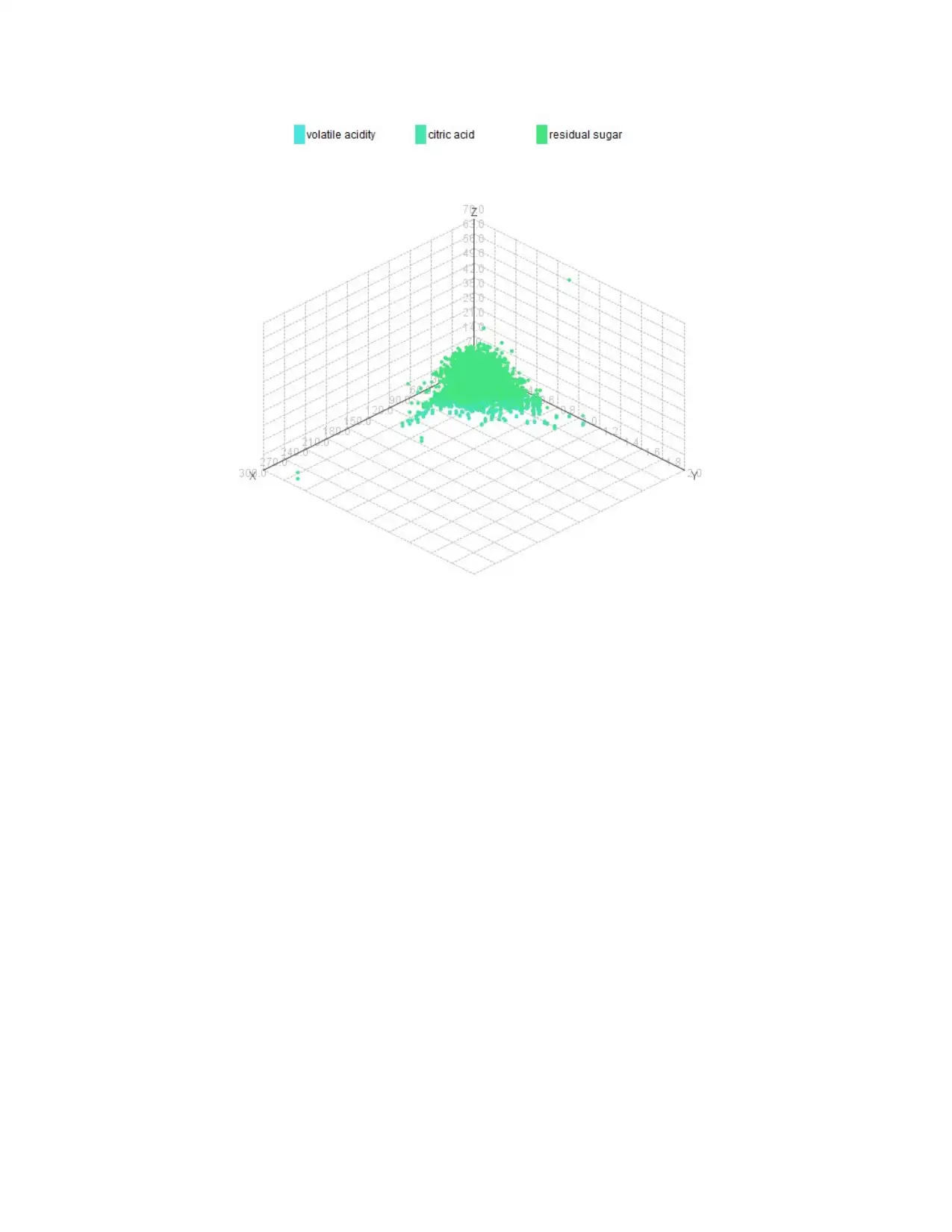
Paraphrase This Document
Need a fresh take? Get an instant paraphrase of this document with our AI Paraphraser


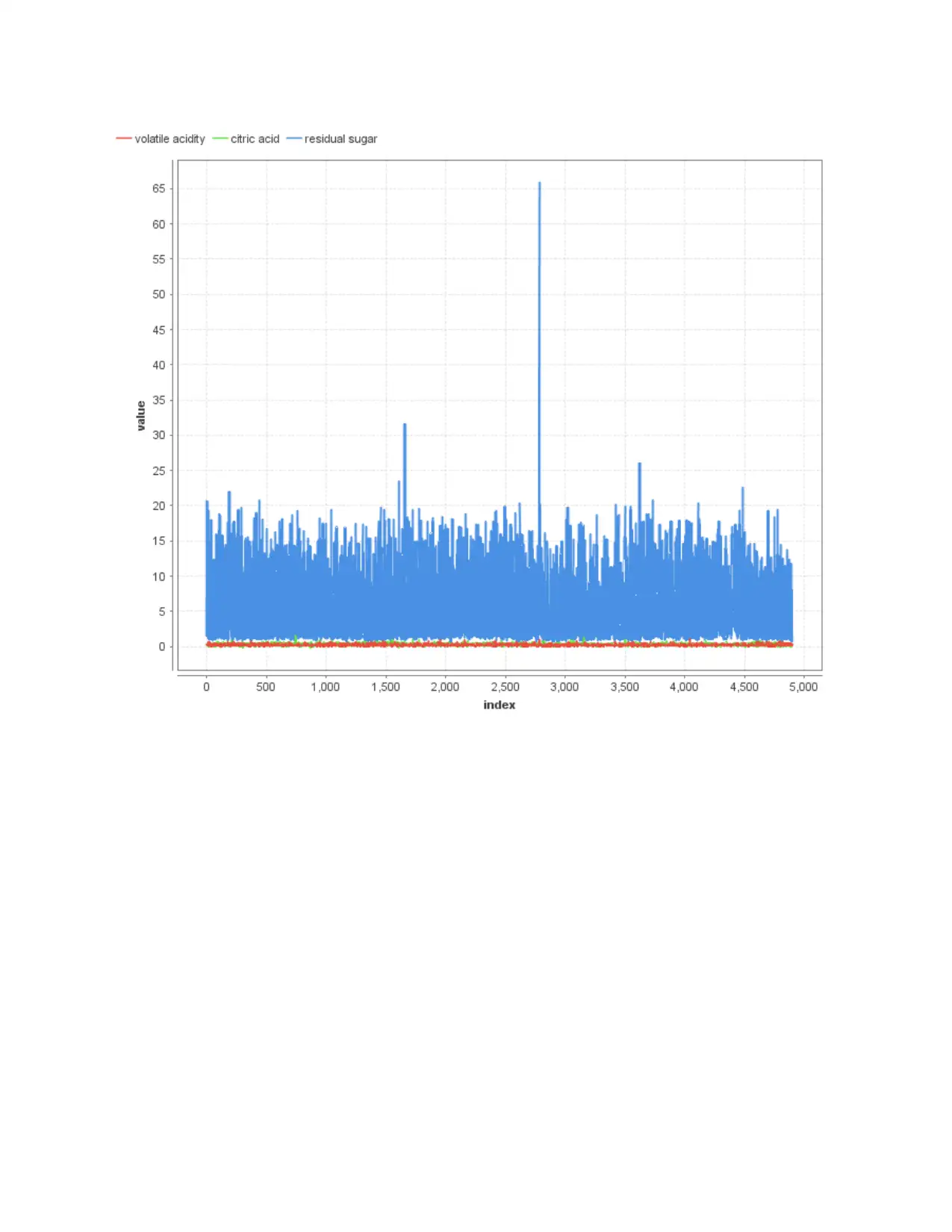
Secure Best Marks with AI Grader
Need help grading? Try our AI Grader for instant feedback on your assignments.
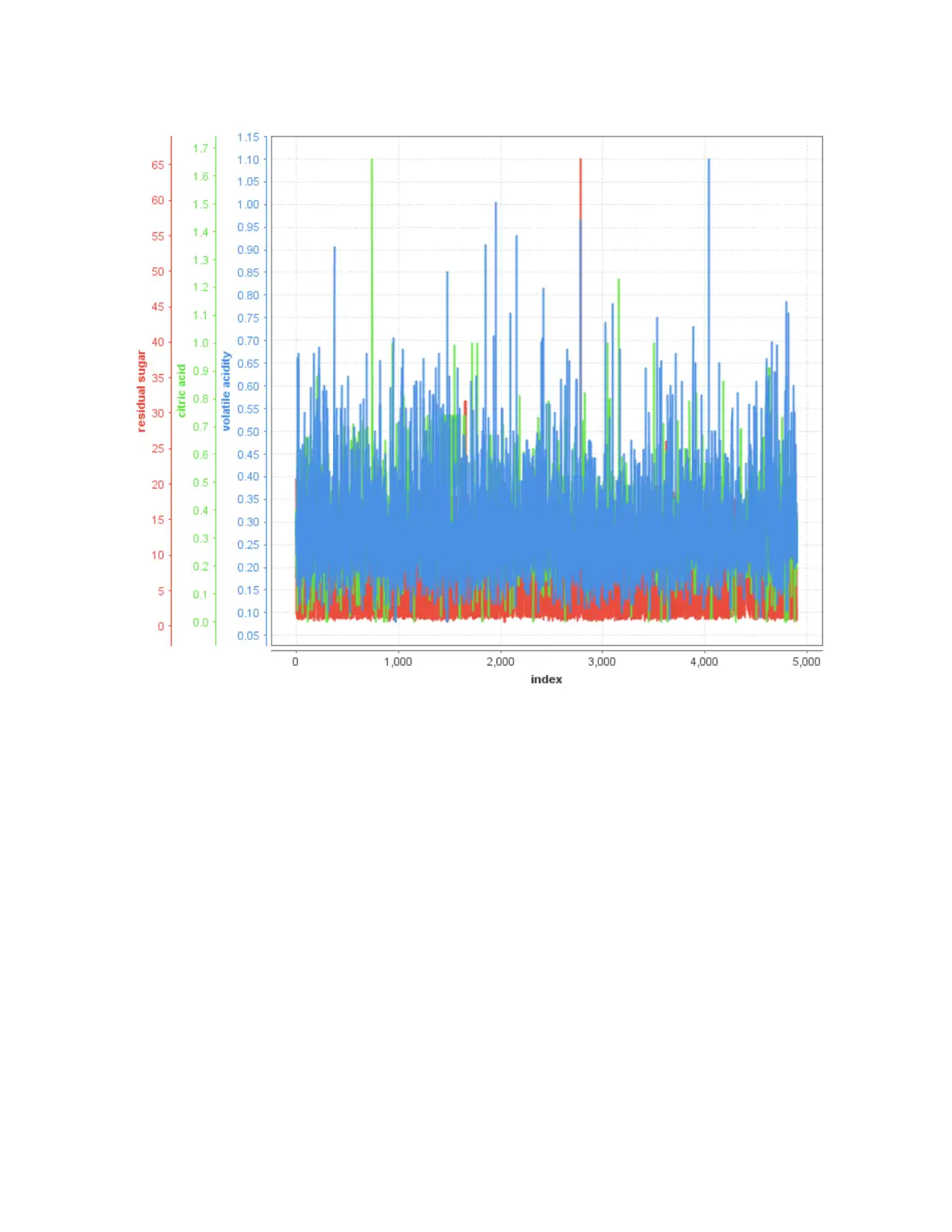

Observations regarding variables: All variables have outliers
o Quality has most values concentrated in the categories 5, 6 and 7. Only a small proportion is in
the categories [3, 4] and [8, 9] and none in the categories [1, 2] and 10.
o Fixed acidity, volatile acidity and citric acid have outliers. If those outliers are eliminated
distribution of the variables may be taken to be symmetric.
o Residual sugar has a positively skewed distribution; even after eliminating the outliers
distribution will remain skewed.
o Some of the variables, e.g . . . . Free sculpture dioxide, density, has a few outliers but these are
very different from the rest.
o Mostly outliers are on the larger side.
Alcohol has an irregular shaped distribution but it does not have pronounced outliers.
o Quality has most values concentrated in the categories 5, 6 and 7. Only a small proportion is in
the categories [3, 4] and [8, 9] and none in the categories [1, 2] and 10.
o Fixed acidity, volatile acidity and citric acid have outliers. If those outliers are eliminated
distribution of the variables may be taken to be symmetric.
o Residual sugar has a positively skewed distribution; even after eliminating the outliers
distribution will remain skewed.
o Some of the variables, e.g . . . . Free sculpture dioxide, density, has a few outliers but these are
very different from the rest.
o Mostly outliers are on the larger side.
Alcohol has an irregular shaped distribution but it does not have pronounced outliers.

Range is much larger compared to the IQR. Mean is usually greater than the median. These observations
indicate that there are outliers in the data set and before any analysis is performed outliers must be
taken care of.
Next we look at the bivariate analysis, including all pairwise scatterplot and correlation coefficients.
Since the variables have non-normal distribution, we have considered both person and spearman rank
correlations.
Task 2.2
Data Preparation
Possibly the most important step in data preparation is to identify outliers. Since this is a multivariate
data, we consider only those points which do not have any predictor variable value to be outside of
limits constructed by boxplots. The following rule is applied:
A predictor value is considered to be an outlier only if it is greater than Q3 + 1.5IQR
The rationale behind this rule is that the extreme outliers are all on the higher end of the values and the
distributions are all positively skewed. Application of this rule reduces the data size from 4899 to 4074.
Data is randomly divided into Training data and Test Data of equal sizes (50% each).
Not all predictors are significant. A forward selection method is employed to build a working model. The
sample R output follows:
indicate that there are outliers in the data set and before any analysis is performed outliers must be
taken care of.
Next we look at the bivariate analysis, including all pairwise scatterplot and correlation coefficients.
Since the variables have non-normal distribution, we have considered both person and spearman rank
correlations.
Task 2.2
Data Preparation
Possibly the most important step in data preparation is to identify outliers. Since this is a multivariate
data, we consider only those points which do not have any predictor variable value to be outside of
limits constructed by boxplots. The following rule is applied:
A predictor value is considered to be an outlier only if it is greater than Q3 + 1.5IQR
The rationale behind this rule is that the extreme outliers are all on the higher end of the values and the
distributions are all positively skewed. Application of this rule reduces the data size from 4899 to 4074.
Data is randomly divided into Training data and Test Data of equal sizes (50% each).
Not all predictors are significant. A forward selection method is employed to build a working model. The
sample R output follows:
Paraphrase This Document
Need a fresh take? Get an instant paraphrase of this document with our AI Paraphraser


Task 3 Tableau Desktop View of Snow Falls at Whistler over Time
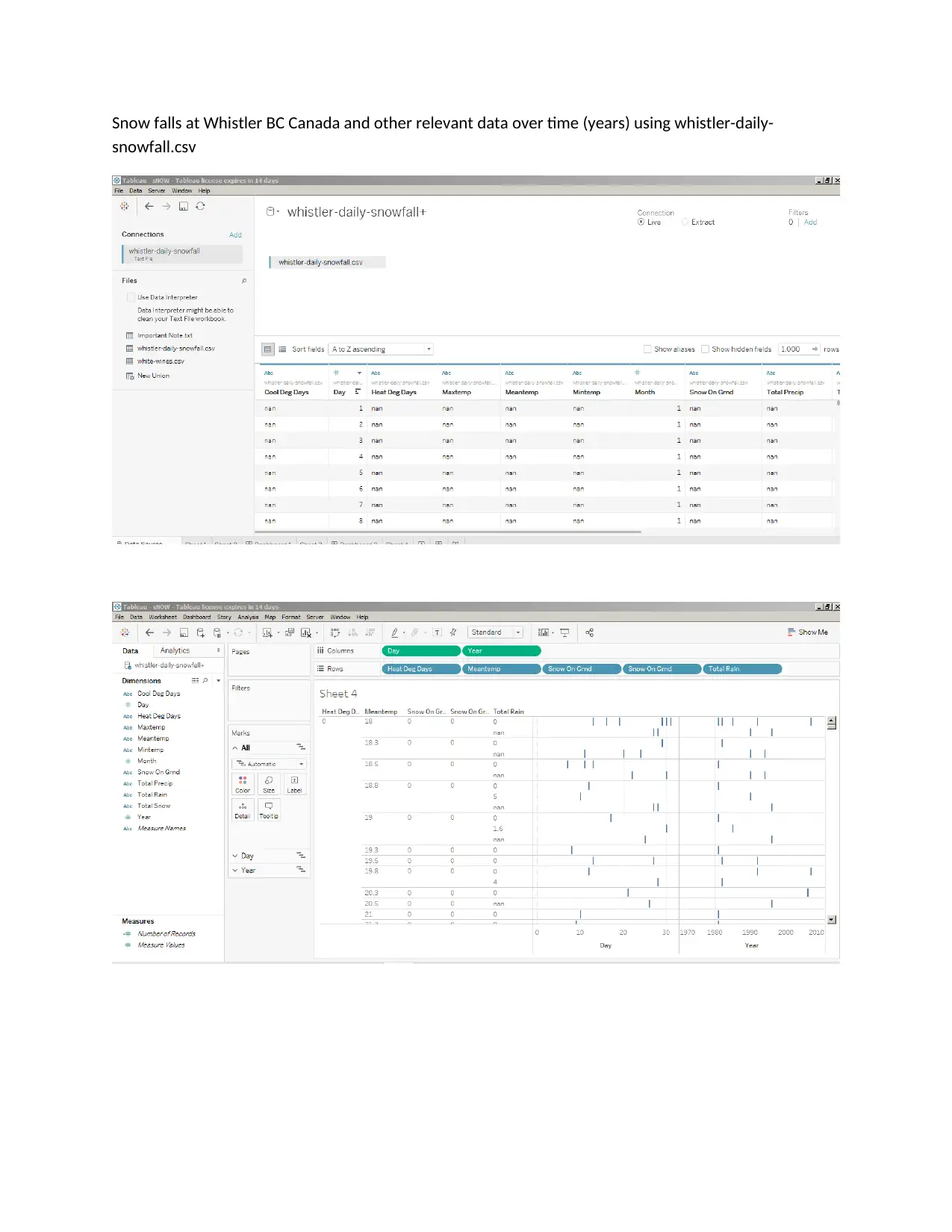
Snow falls at Whistler BC Canada and other relevant data over time (years) using whistler-daily-
snowfall.csv
snowfall.csv
Secure Best Marks with AI Grader
Need help grading? Try our AI Grader for instant feedback on your assignments.
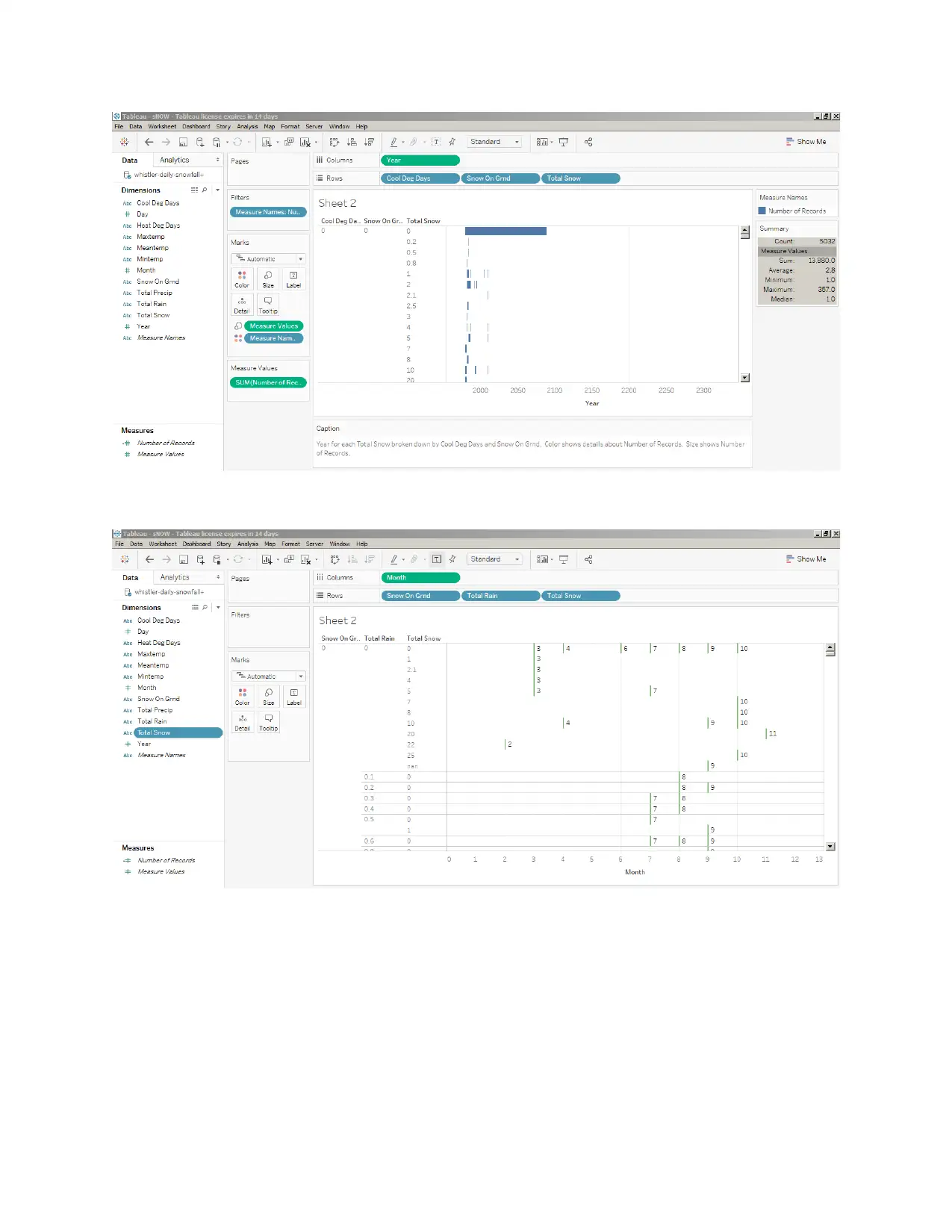
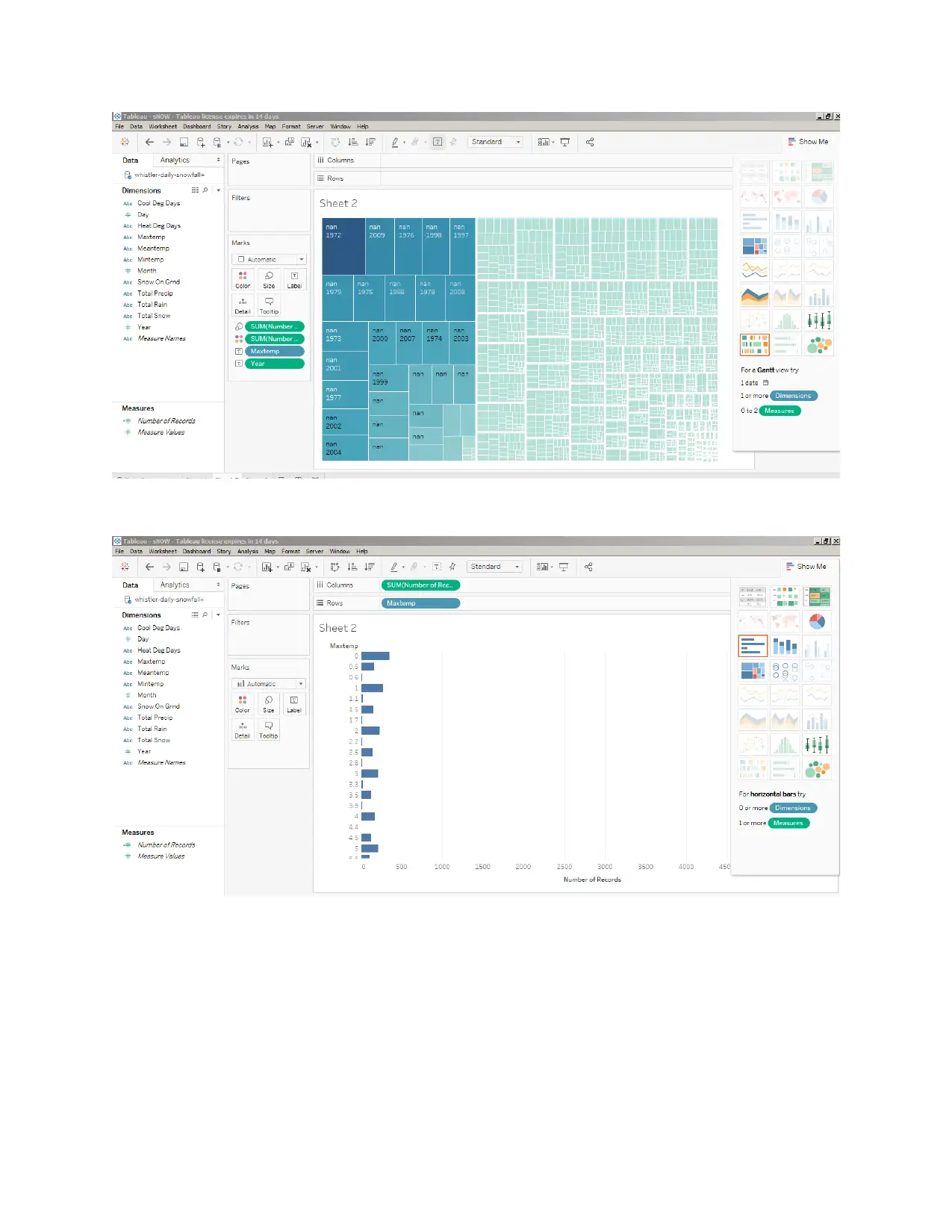
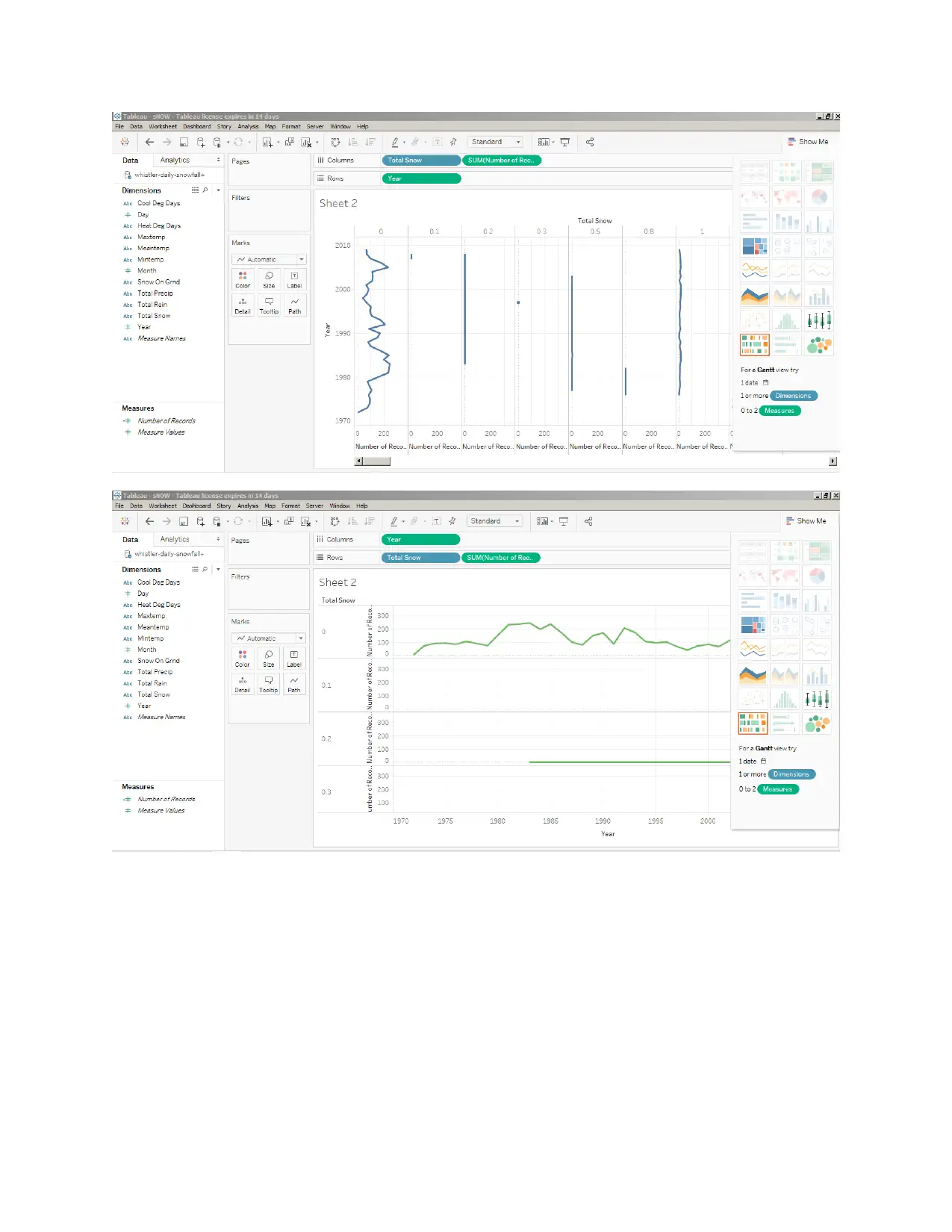
Paraphrase This Document
Need a fresh take? Get an instant paraphrase of this document with our AI Paraphraser
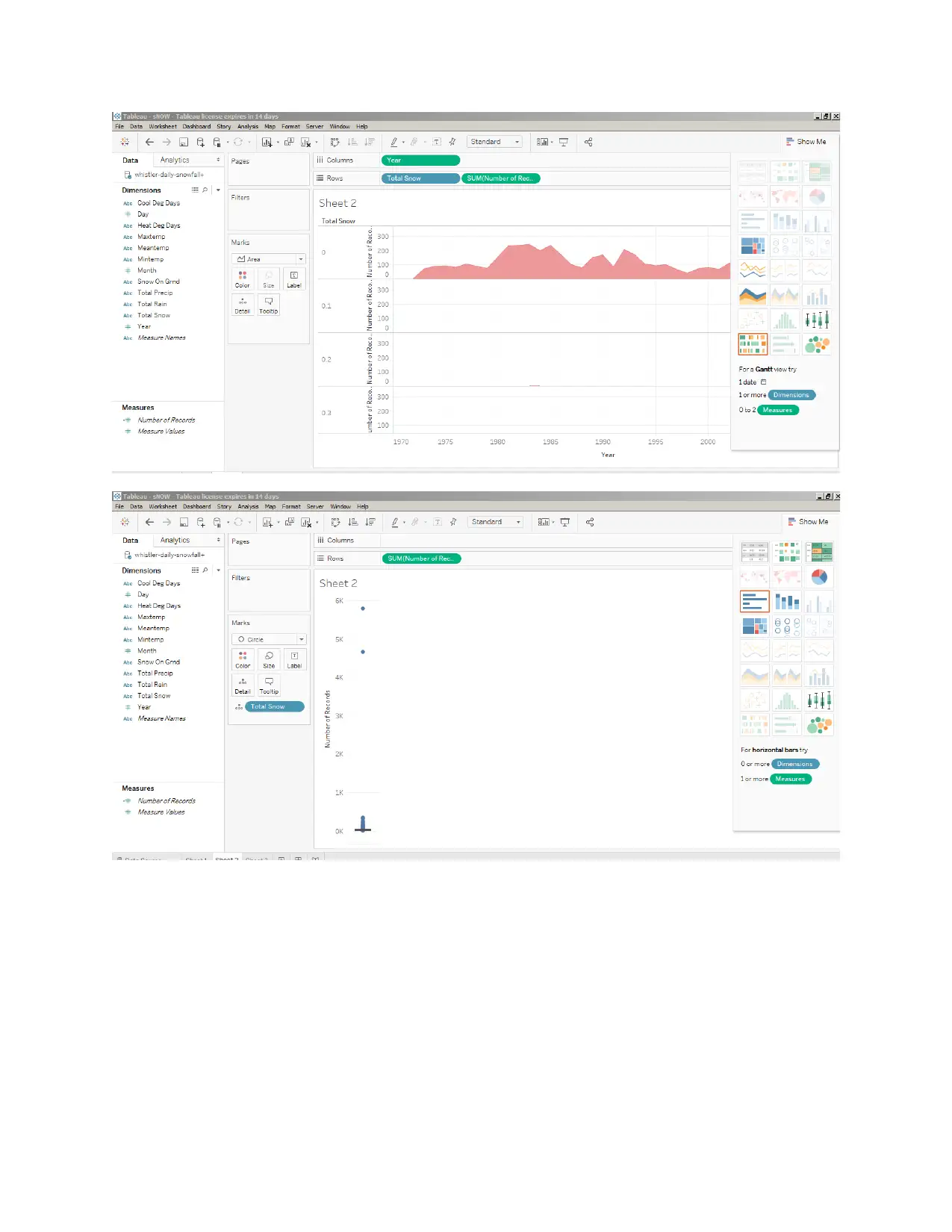
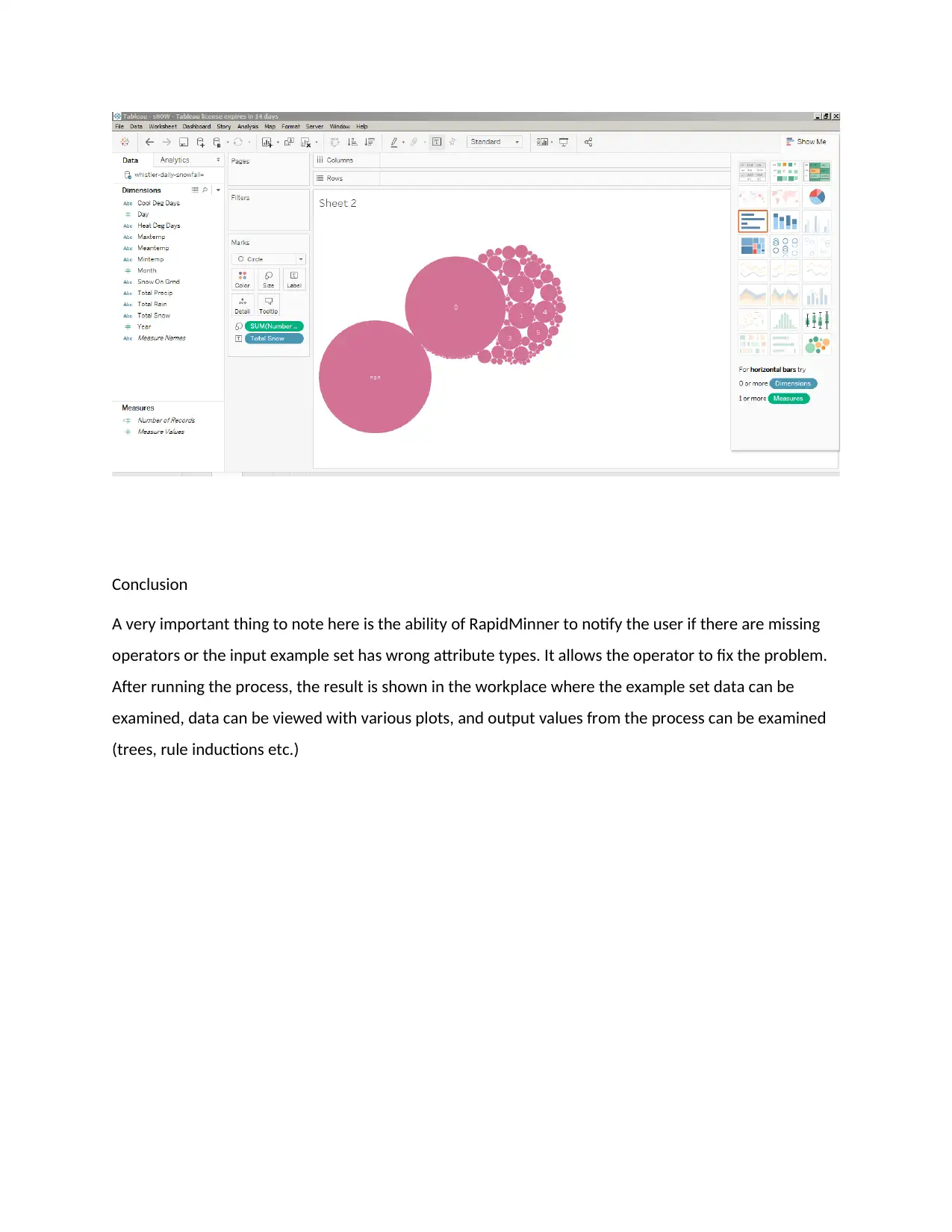
Conclusion
A very important thing to note here is the ability of RapidMinner to notify the user if there are missing
operators or the input example set has wrong attribute types. It allows the operator to fix the problem.
After running the process, the result is shown in the workplace where the example set data can be
examined, data can be viewed with various plots, and output values from the process can be examined
(trees, rule inductions etc.)
A very important thing to note here is the ability of RapidMinner to notify the user if there are missing
operators or the input example set has wrong attribute types. It allows the operator to fix the problem.
After running the process, the result is shown in the workplace where the example set data can be
examined, data can be viewed with various plots, and output values from the process can be examined
(trees, rule inductions etc.)

References
[1] Wikipedia, http://en.wikipedia.org/wiki/Data_analysis.
[2] J. Luan, Data Mining and Its Applications in Higher Education, 2004.
[3] S. Ayesha, T. Mustafa, A.R. Sattar, M.I. Khan, Data Mining Model for Higher Education System,
European Journal of Scientific Research ISSN 1450-216X Vol.43 No.1 (2010), pp.24-29
[4] R.S.J.d. Baker, J.E Beck. (2008). Preface. Proceedings of the First International Conference on
Educational Data Mining,pp. 2.
[5] A.N. Rafferty, M. Yudelson, Applying Learning Factors Analysis to Build Stereotypic Student Models,
Stanford University, University of Pittsburgh
[6] R.S.J.d. Baker Data Mining for Education Carnegie Mellon University, Pittsburgh, Pennsylvania, USA
[7] C. Romero , S. Ventura, Educational data mining: A survey from 1995 to 2005, Department of
Computer Sciences, University of Cordoba, Cordoba, Spain,2006
[8] R. Baker, K. Yacef, The State of Educational Data Mining in 2009: A Review and Future Visions
[9] S. Abbas, H. Sawamura, Developing an Argument Learning Environment Using Agent-Based ITS (ALES)
[10] P. Baepler, C. J. Murdoch, Academic Analytics and Data Mining in Higher Education, International
Journal for the Scholarship of Teaching and Learning, Vol. 4, No. 2 (July 2010), ISSN 1931-4744 @
Georgia Southern University
[1] Wikipedia, http://en.wikipedia.org/wiki/Data_analysis.
[2] J. Luan, Data Mining and Its Applications in Higher Education, 2004.
[3] S. Ayesha, T. Mustafa, A.R. Sattar, M.I. Khan, Data Mining Model for Higher Education System,
European Journal of Scientific Research ISSN 1450-216X Vol.43 No.1 (2010), pp.24-29
[4] R.S.J.d. Baker, J.E Beck. (2008). Preface. Proceedings of the First International Conference on
Educational Data Mining,pp. 2.
[5] A.N. Rafferty, M. Yudelson, Applying Learning Factors Analysis to Build Stereotypic Student Models,
Stanford University, University of Pittsburgh
[6] R.S.J.d. Baker Data Mining for Education Carnegie Mellon University, Pittsburgh, Pennsylvania, USA
[7] C. Romero , S. Ventura, Educational data mining: A survey from 1995 to 2005, Department of
Computer Sciences, University of Cordoba, Cordoba, Spain,2006
[8] R. Baker, K. Yacef, The State of Educational Data Mining in 2009: A Review and Future Visions
[9] S. Abbas, H. Sawamura, Developing an Argument Learning Environment Using Agent-Based ITS (ALES)
[10] P. Baepler, C. J. Murdoch, Academic Analytics and Data Mining in Higher Education, International
Journal for the Scholarship of Teaching and Learning, Vol. 4, No. 2 (July 2010), ISSN 1931-4744 @
Georgia Southern University
1 out of 28
Your All-in-One AI-Powered Toolkit for Academic Success.
+13062052269
info@desklib.com
Available 24*7 on WhatsApp / Email
![[object Object]](/_next/static/media/star-bottom.7253800d.svg)
Unlock your academic potential
© 2024 | Zucol Services PVT LTD | All rights reserved.



